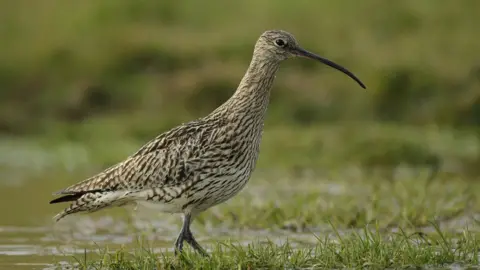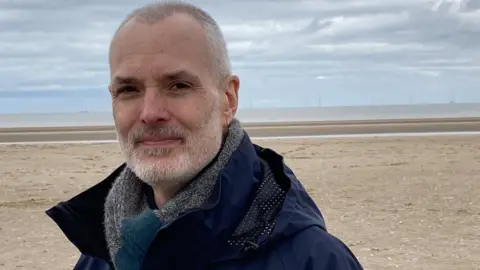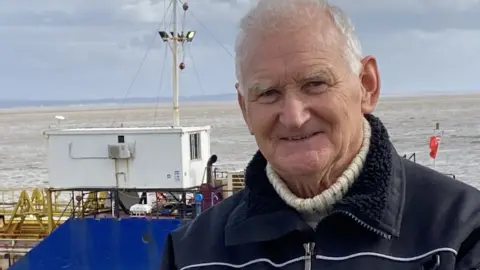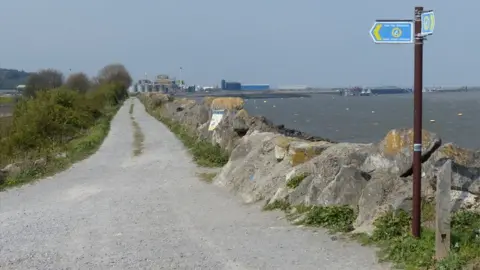Tidal lagoon: Wildlife fears over Dee estuary plans
 Andy Hay (RSPB)
Andy Hay (RSPB)Plans to build Wales' first tidal lagoon in a conservation area could harm wildlife, environmentalists fear.
Mostyn SeaPower Ltd hopes turbines on the Dee Estuary in Flintshire will provide electricity for 82,000 homes.
But environmental campaigners fear the development could damage birds due to the disruption of their habitat.
The company said ecological surveys had been carried out and there would be "no significant impacts" on wildlife.
Mostyn Seapower Ltd, a subsidiary of the Port of Mostyn, hopes to construct the £600m tidal lagoon, which would be the first of its kind in Wales.
At about 4.2 miles (6.7km) in length, the lagoon wall would run along the estuary between Mostyn and Point of Ayr.
The lagoon would cover an enclosed area of 12.2 km (7.6 miles) and, at high tides, would hold 72 million cubic metres of water.
But while the company say with a rising energy crisis, now is the time for green energy development, others fear the location of the tidal lagoon could lead to a loss of habitat for birds.

"The Dee Estuary is one of the most heavily protected sites in the world," Adrian Lloyd Jones of the North Wales Wildlife Trust said.
Mr Lloyd Jones said the area was Site of Special Scientific Interest, a Special Area of Conservation, and a Ramsar Site, a wetland site designated to be of international importance.

Analysis by Sarah Dickins, BBC Wales economics correspondent
Developers in Wales are hoping to be the first in the UK to successfully generate electricity from the tides .
The argument for it is that it is clean and utterly predictable for generations.
Mostyn is one of three sites in Wales where plans for tidal lagoons are being developed.
The failure of the Swansea Tidal Lagoon project in 2018 hovers in the background, raising questions about whether these current projects will work .
We are in very different times now, as the UK recognises it needs to rely less on energy from overseas.
Financial institutions are also seeking out projects to invest in that help to move towards Net Zero.
Pressure is on governments to speed up the licensing process so they can get started.

He said with 24,000 Pink-footed Geese recorded on the Dee Estuary in the last year, the site was also a key site for Cormorants, Curlews and Little Egrets.
"There are probably better places to do it," he added. "Almost every sort of wading bird is here."
"I think it's very important that we do cut carbon emissions and I think developments like this can be ways of doing that," he said.

The company behind the proposals says the scheme would create 300 construction jobs and employ 35 people during its operational life of over 100 years.
It hopes to complete it by the end of 2027 and recently invited bids to review the initial design and costings for the scheme.
"This will be home grown. It will be on North Wales' doorstep. It will be North Wales' energy," said managing director Jim O'Toole.
Mr O'Toole said the company had been in talks with Natural Resources Wales (NRW) from the very start and was now in its second year of ecological surveys of the priority species of fish, birds and mammals in the Dee Estuary.
"We will be going through the hoops as NRW will put us through the hoops - rightly - and we believe, from what we know already, that there won't be significant impacts on the wildlife," he said.
Mr O'Toole said the lagoon could even bring environmental benefits.
"For instance, the lagoon walls that we are going to build will be a flood protection for about four and a half miles of the hinterland, which is also the coast road and the main railway line between Crewe and Holyhead."
Energy security
The developers hope to have their environmental reports completed by the end of this year, with a formal planning application going in next year, with the company confident it can raise the £600m to fund the project.
Dr Edward Thomas Jones, a lecturer in economics at Bangor University, said the project could have a "significant impact on the north Wales economy" and attract companies to the region.
"Especially given what's happening currently in Ukraine. Energy security is becoming very important," he said.
"It's a renewable source of energy and that will be very attractive to a lot of companies to locate to north Wales to make use of that energy source," he added.
"We have to remember, here in north Wales, we do have a strong manufacturing base still and these are very energy-intensive industries. And so this energy security is going to be critical for them and, of course, that added bonus then of being a renewable clean energy source - it's great for the region."
 Mat Fascione | Geograph
Mat Fascione | GeographBut Mr Jones, of North Wales Wildlife Trust, said he remained concerned whether environmental studies could accurately gauge the impact such a development would have on wildlife.
"Obviously, putting such a large structure in a very dynamic habitat will have consequences that are very, very hard to predict," he said.
"How will it affect the mudflats that all these species feed on? I mean, that's almost unknowable. So we would really want to see the data on that before we'd be satisfied it's not going to have a detrimental impact."

- STARS OF WALES: World class Welsh musical talent
- LAST CHANCE TO SAVE: Will Millard explores some of Wales’s hidden historic buildings

